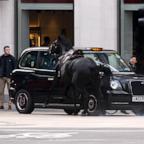Book Excerpt: 'Firehouse'
May 30 -- In Firehouse, David Halberstam explores what happened to the courageous firefighters from New York City's Engine 40 firehouse on Sept. 11. In the first chapter of his book, which is excerpted below, Halberstam offers details about the firehouse's history.
Chapter 1
The Upper West Side of Manhattan, just above Columbus Circle, was until quite recently a relatively poor neighborhood, and some of the veteran firemen at Engine 40, Ladder 35, located at Sixty-sixth Street and Amsterdam Avenue, like to recall how Amsterdam was once the dividing line between an Irish neighborhood to the east and a black neighborhood, just to the west. The black neighborhood used to be known as San Juan Hill, some say in honor of the black soldiers who moved there after the Spanish-American War, or perhaps because of the frequent, bloody street fights that occurred between the Irish and black kids early in the century, or finally because some of the city's earliest Puerto Rican settlers lived there. But after World War II, as the city became ever more affluent, as every piece of real estate in Manhattan became more and more valuable, the neighborhood began to change. The tenements that had housed the poor, where bookies haunted the hallways and homing pigeons were sometimes still kept on the roofs, and the cheap single-room occupancy (SRO) hotels, in which rooms rented for five dollars a night, began to disappear, to be replaced by solidly middle-class apartment buildings. The process accelerated in 1959 with the groundbreaking for Lincoln Center, a vast new cultural complex that would house the Metropolitan Opera, the New York City Ballet, the New York Philharmonic, and the Juilliard School.
In the early 1960s, skyscrapers began to sprout into the sky like giant steel-and-glass fingers. What had before been barely a blue-collar neighborhood became not merely middle class, but in time, upper-middle class. The firemen and cops who worked the area, many of whose families lived in the neighborhood and in other working-class sections of Manhattan, were caught in this relentless process of economic and social change, and they began to move, first to the boroughs — Queens, Brooklyn, and State Island — and then, in the last twenty years, to the satellite commuter communities surrounding New York City, on Long Island, and north of the city in Rockland County, New York, and in New Jersey.




